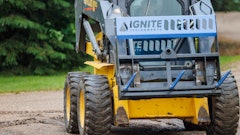
In-place recycling and stabilization involving foamed asphalt and lime slurry can help Texas governments rehabilitate and upgrade their vast network of state secondary, county and Farm-to-Market roads at a fraction of the cost of a conventional reconstruction, a field test late last season demonstrated.
Just northeast of Austin, for three days in November 2012, Williamson County Road 424 was the site of an in-place full-depth reclamation and stabilization demonstration involving Wirtgen WR 2400 and WR 2500 S recycler/reclaimers. The demonstration, or test section, was a collaboration between Wirtgen America Inc., Williamson County Road and Bridge Division, and Cooper Equipmment Co.
Using the WR 2400, the pavement first was stabilized to a 5-in. depth with lime slurry. Then -- while state, county and municipal public works staff visited over a two-day period – the WR 2500 S foamed the reclaimed pavement to a depth of 5 inches.
While two recycler/reclaimers were used, a single machine could have done the trick. “We used the WR 2400 and WR 2500 S machines because they were available,” said Mike Marshall, director of recycling products, Wirtgen America Inc. “However this process could equally be accomplished with a single unit. Also capable of this work are the WR 2000 XL, WR 240i or WR 250 when equipped with appropriate spray systems.”
Low volume, but heavy loads
Country roads don’t get the traffic counts that their urban and suburban cousins get, so they rank low as a funding priority. Yet they experience crushing loads from overweight farm vehicles during harvest season, which severely damage the road structure.
The owning agency is conflicted with the need to spend money to improve rural road ride quality, while knowing funds will serve more motorists if spent elsewhere. Agencies need a cost-effective method to rebuild the road; full-depth reclamation (FDR) is one answer to this dilemma.
The problem is worsened as urbanization creeps out into formerly rural counties, as Austin is doing to Williamson County. “Our Williamson County roads are getting a lot more use and traffic than they originally were designed for,” said Terron Evertson, P.E, director of Road and Bridge Division, Williamson County, Tex.
“Our county is experiencing rapid growth, having doubled in population in the last 10 years,” says Terron Evertson, P.E., director of the Williamson County Road and Bridge Division. “We see our county roads that once provided local access to farms and residences becoming collectors and arterials. We also see farm equipment getting larger and heavier, and it takes a toll on our roadway system, as well. Many of our CR-designated roads need attention, and they need it quickly.“
A vast majority of Williamson County rural, CR-designated, county roads have little or no pavement structure beneath the surface. Many of these roads have received numerous patches and repairs in the past, but not a fix that meets the desirable life cycle for this classification of roadway.
Traditional construction means and methods for augmenting existing pavement structures, or introducing a pavement structure where none previously existed have included excavation of unsuitable base and subgrade material, and replacing it with a graded crushed limestone base material.
In addition, many areas of eastern Williamson County are plagued with expansive soils with high PIs that also need to be addressed with mechanical or chemical stabilization. These traditional construction means and methods are extremely time-consuming. Because Williamson County has experienced such a high growth rate, there is a need to rehabilitate a large number of roads in a short period of time.
The problem is exacerbated as urbanization creeps outward into formerly rural communities. “Our Williamson County roads are getting a lot more use and traffic than they originally were intended, for,” Evertson says.
Full-depth reclamation
Not only do agencies need a cost-effective method to rebuild roads, but also one that can be accomplished in a timely manner. Full-depth reclamation (FDR) is one answer to the problem.
“County Road 424 suffered from base failure, oxidization and cracks,” said Wirtgen’s Marshall. “It was totally out of shape, and the problem with roads like these is that they are not heavily trafficked, except twice a year during harvest time.
Expansive clay under the pavement complicated the problem, Marshall said. The pavement was so heavily cracked every time it rained, water would get into the clay below, he said. The clay would expand, and the road would further deteriorate. “The reclamation process not only eliminates all the cracks; it seals the road while rebuilding the base, and prevents water from coming in,” Marshall said. “It’s a long-term solution.”
There is a low maintenance budget for this type of road because of low traffic, so the roads experience a lot of superficial chip seals, patching and other treatments, Marshall said. But surface treatments can only do so much. When used on aging but stable pavements still in good shape, these treatments will substantially prolong pavement life. But when used on failing pavements, they don’t address the fundamental structural problem, and also contribute to ride issues. Money spent on surface treatments then is not used to its best advantage.
Flexible layer closes cracks
To see if the road was a candidate for FDR, 250 lb. of road samples were sent to Wirtgen America’s lab in Nashville, and mix designs were run using the Wirtgen WLB 10 S foamed bitumen lab.
To tame the cracking, a preliminary pass mixed lime into the pavement structure. “Our first pass introduced 3 percent residual lime to reduce the P.I. [plasticity index] of the clay, and the pavement was shaped and compacted to allow for traffic and left for 24 hours,” Marshall said.
The lime was introduced as a slurry, and a WR 2400 pushed the lime slurry truck forward as it pulverized the existing pavement. That lime slurry was pumped into the WR 2400’s mixing chamber, where it was mixed uniformly into the existing road.
“This was the first time that Williamson County had injected lime slurry directly into a mixing chamber,” Marshall said. “Typically lime slurry will go on top of the pavement, and be mixed from top down, which can lead to an irregular mix in the pavement. The use of a mixing chamber results in a much higher uniform quality mix.”
After that period, a second pass was undertaken with 2.4 percent foamed asphalt, produced within the WR 2500 S. This pass was witnessed by the participants. “This will build a good, flexible base that will withstand the clay movement underneath, while accommodating the surface traffic,” Marshall said.
Foamed asphalt or bitumen mixes incorporate liquid “foamed” bitumen or asphalt as a stabilizing agent, in which hot performance-grade asphalt is foamed with water and air, and is then injected into reclaimed materials or aggregate in a mixing chamber.
Precise addition of water allows control of the rate and amount of asphalt foam expansion. The expanded asphalt has a resulting high surface area available for bonding throughout the materials, leading to a stable cold mix that can be overlaid with a thin wearing course. This foamed asphalt mix is placed, graded and compacted, and can permit traffic – including heavy trucks – almost immediately.
The project itself was one mile long by 21 ft. wide. The construction crew was made up of Williamson County employees, using equipment and technical support lent by the local distributor, Cooper Equipment Co., and also Wirtgen America. The three-day project began with lime stabilization of the entire project, then two days in which a half-mile was foam-stabilized in three passes each day.
Following compaction of the 5-in. stabilized layer with the Hamm 3412 P padfoot roller, the recycled layer was cut to grade and crown using a motor grader. Recompaction of that surface followed with a steel-drum vibratory roller, and the final surface was finish-rolled with a Hamm GRW 280 pneumatic roller, ballasted to 15 tons.
Finally, a chip seal – or seal coat in the Texas vernacular – was placed over the foam-stabilized, reclaimed base. “A chip seal is quite adequate for the traffic of this kind of road,” Marshall said. “What we have here is a very economical, long-term solution to a high maintenance problem. And because it’s a low-traffic road, foamed asphalt FDR is an ideal solution to the problem.”
The field demonstration took place over a two-day period, and it drew visitors both days. “The project generated a lot of interest within the community because a lot of surrounding agencies have very similar problems,” Marshall said. “If we can provide a solution in Williamson County we will have a solution for the surrounding governments.”
“We showed in the demo that you can recycle the pavement and stabilize the material, put it down and have it open to traffic in a day,” Evertson said. “The production speed is there. We will be looking at what happens, but everything I am hearing is that the pavement is a flexible structure that should behave well with the shrink-swell soils and the traffic loads.”



















